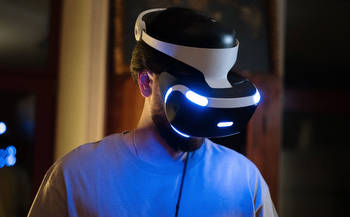How Artificial Intelligence Has Revolutionized the Gaming World

Increasingly powered by artificial intelligence, sales in the video gaming industry are anticipated to increase significantly in 2022. If you’re a hard-core, veteran gamer, then the recent advances in gaming technology are probably not lost on you. You’ve likely already seen first-hand how gaming has improved by light years since the old arcade scene.
For example, one of the best-selling early video games was Pac-Man. Gamers played Pac-Man on a relic game system known as Atari 2600. That antiquated setup doesn’t hold a candle to the games played today on the new Atari VCS 800.
The current scene for gaming is all about high-tech, cutting-edge innovations that submerge the gamer into a completely different reality. Design, software development, and a lot of coding are integral to manifesting a superior game experience. Increasingly, though, artificial intelligence (AI) is playing a huge role in satisfying gamers around the world.
This year, the expected purchase of gaming hardware is also positioned to enjoy continued success in sales. These increases in sales are directly related to the demand for role-playing games (RPG) and other AI-driven gaming experiences that are continually improving over the years.
So if gaming is in your wheelhouse, read on. Learn how AI has revolutionized the world of game-play and will continue to do so in the future.
The Role of Artificial Intelligence in Gaming
With the exception of casino games (such as digital slot machines), AI is used in just about every video game on the market.
AI cannot be used in games of chance, such as slots. The whole idea is that the results must be random and thus the gambler has a “fair shot” at winning. Games of chance excepted, other games use AI to improve and enhance objective-driven game experiences. Video games progress upon somewhat predictable timelines and must have measurable outcomes.
AI in video games has become essential for reading the gamer’s movements and behavior. After assessing the user’s responses to the game, AI makes calculated predictions as to what the user will do next. Once this information is processed, AI takes over in providing the user with a more dynamic experience. This is accomplished by AI establishing different scenarios in the game that provide challenges for the gamer according to his or her interaction with the game.
In short, AI “thinks” its way through the game. It modifies the gaming experience according to the gamer’s input. Without AI, games would be as bland as Pong, one of Atari’s first video games. Pong is like playing tiddlywinks compared to today’s mind-boggling video adventures available for pro gamers and amateurs alike.
AI and Gaming: The Early Days
The first notable use of AI in gaming was utilized by one of the first small-scale computers called the Ferranti Mark 1. It was designed and built by the University of Manchester.
That precursor to the game consoles we see today began its journey into AI gaming first with a basic (but effective) program written to play checkers. Later, the console employed an AI-enhanced strategy for a computerized chess game. While wildly simplistic, the checkers and chess computer games were the ancestors of the intricate AI games we see today.
Those prototypes, written by Arthur Samuel, were critical in building a foundation for AI.
These progenitors were first developed in the 1950s and 1960s. Since that time, we’ve developed stellar improvements in AI technology. In fact, advancements in AI software testing, graphic design, and overall user experience upgrades have revolutionized the gaming experience from those early days of pixelated chess pieces moving on a computer screen.
AI continued making noticeable strides in the gaming world in the 1970s. It’s becoming more popular and in demand with every passing decade. In fact, the early Atari smash-hit mentioned earlier, Pac-Man, used AI to improve user experiences in the 1980s. And, of course, AI continues to evolve.
The Evolution of AI in Gaming Over the Decades
From simple computerized board games, AI started to expand its role in more advanced games in the 1980s.
For example, in 1988, an action role-playing game known as First Queen was the first RPG to feature characters or avatars that were controlled by AI tech. Another popular competitive fighting-style AI-fueled game known as Karate Champ also saw a great deal of popularity in the 1980s.
You might be familiar with the hugely popular RPG, Dragon Quest IV. This RPG was a game-changer for AI. It allowed the players to adjust the AI routines of computer-generated characters during fight scenes.
Artificial Intelligence Calls the Shots in Sports Video Games
Artificial intelligence also changed the face of sporting gaming from the mid-1980s to the early 1990s.
For example, NHL ’94 by EA Games brought the excitement, blood, and gore of hockey to the game screen. NHL ’94 used AI to allow gamers to check players on the bench or fire a one-off. It also included real team players to get a full-bodied experience with a joystick.
Part of the reason AI boosted popularity in sports games is because it hugely expanded upon the user experience. With AI, players were now able to create computerized coaching and managerial tactics from real-life coaches.
For example, one of the most beloved sports games is Madden Football. It’s still the most popular today among gaming sports fans. This is due in no small part to its integrated and sophisticated use of AI. Madden Football has the capacity to lay out real-time game statistics and decisions. Add in AI pathfinding capabilities and strategic planning and Madden Football blew the sports gaming world out of the water.
Gamers love the unforgettable “Boomshakalaka” cries in NBA Jam. They respond enthusiastically to Ken Griffey Jr. Presents Major League Baseball by Saga. They devour Tony Hawk’s Pro Skater for Playstation. These early examples of AI in sports games have grown gaming into a billion-dollar industry.
What’s more, AI has spawned a meteoric rise in all types of gaming genres. From virtual reality tomb raiding to creating a virtual ecosystem or society via gameplay, AI is at the heart of all gaming industry trends today.
AI and the Gaming Industry Today
According to video game industry revenue statistics, 81% of Americans play and pay for games online or on game stations. Additionally, the video game industry hauled in a whopping $179 billion dollars in revenue for 2021 worldwide.
Analysts expect that figure to rise by 25% or more in the future. And this is a conservative estimate, given the ongoing occurrences of global pandemic-related shut-ins. The statistics continue to be mind-blowing. It’s clear that artificial intelligence will continue to innovate and revolutionize the gaming industry long into the future.



































